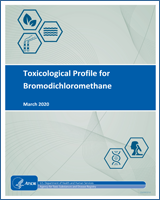NCBI Bookshelf. A service of the National Library of Medicine, National Institutes of Health.
Toxicological Profile for Bromodichloromethane. Atlanta (GA): Agency for Toxic Substances and Disease Registry (US); 2020 Mar.

Toxicological Profile for Bromodichloromethane.
Show detailsThe objective of the toxicological profile is to evaluate the potential for human exposure and the potential health hazards associated with inhalation, oral, or dermal/ocular exposure to bromodichloromethane.
B.1. LITERATURE SEARCH AND SCREEN
A literature search and screen was conducted to identify studies examining health effects, toxicokinetics, mechanisms of action, susceptible populations, biomarkers, chemical interactions, physical and chemical properties, production, use, environmental fate, environmental releases, and environmental and biological monitoring data for bromodichloromethane. ATSDR primarily focused on peer-reviewed articles without publication date or language restrictions. Non-peer-reviewed studies that were considered relevant to the assessment of the health effects of bromodichloromethane have undergone peer review by at least three ATSDR-selected experts who have been screened for conflict of interest. The inclusion criteria used to identify relevant studies examining the health effects of bromodichloromethane are presented in Table B-1.
Table B-1Inclusion Criteria for the Literature Search and Screen
|
|
B.1.1. Literature Search
The current literature search was intended to update the draft toxicological profile for bromodichloromethane released for public comment in 2018. The following main databases were searched in May 2019:
- PubMed
- National Library of Medicine’s TOXLINE
- Scientific and Technical Information Network’s TOXCENTER
The search strategy used the chemical names, Chemical Abstracts Service (CAS) numbers, synonyms, Medical Subject Headings (MeSH) headings, and keywords for bromodichloromethane. The query strings used for the literature search are presented in Table B-2.
The search was augmented by searching the Toxic Substances Control Act Test Submissions (TSCATS), NTP website, and National Institute of Health Research Portfolio Online Reporting Tools Expenditures and Results (NIH RePORTER) databases using the queries presented in Table B-3. Additional databases were searched in the creation of various tables and figures, such as the TRI Explorer, the Substance Priority List (SPL) resource page, and other items as needed. Regulations applicable to bromodichloromethane were identified by searching international and U.S. agency websites and documents.
Review articles were identified and used for the purpose of providing background information and identifying additional references. ATSDR also identified reports from the grey literature, which included unpublished research reports, technical reports from government agencies, conference proceedings and abstracts, and theses and dissertations.
Table B-2Database Query Strings
| Database search date | Query string |
|---|---|
| PubMed | |
| 05/2019 | (75-27-4[rn] OR “bromodichloromethane”[nm] OR “BDCM”[tw] OR “Bromo-dichloromethane”[tw] OR “Bromodichlormethane”[tw] OR “Bromodichloromethane”[tw] OR “Dichlorobromomethane”[tw] OR “Dichloromonobromomethane”[tw] OR “Methane, bromodichloro-”[tw] OR “Monobromodichloromethane”[tw]) AND (2014/12/01 : 3000[dp] OR 2015/12/01 : 3000[edat] OR 2015/12/01 : 3000[crdt] OR 2015/12/01 : 3000[mhda]) |
| Toxline | |
| 05/2019 |
(75-27-4[rn] OR “BDCM” OR “Bromo-dichloromethane” OR “Bromodichlormethane” OR “Bromodichloromethane” OR “Dichlorobromomethane” OR “Dichloromonobromomethane” OR “Methane, bromodichloro-” OR “Monobromodichloromethane”) AND ( ANEUPL [org] OR BIOSIS [org] OR CIS [org] OR DART [org] OR EMIC [org] OR EPIDEM [org] OR HEEP [org] OR HMTC [org] OR IPA [org] OR RISKLINE [org] OR MTGABS [org] OR NIOSH [org] OR NTIS [org] OR PESTAB [org] OR PPBIB [org] ) AND NOT PubMed [org] AND NOT pubdart [org] Year of Publication 2015 through 2019 |
| Toxcenter | |
| 05/2019 |
FILE ‘TOXCENTER’ ENTERED AT 10:31:35 ON 03 MAY 2019
|
Table B-3Strategies to Augment the Literature Search
| Source | Query and number screened when available |
|---|---|
| TSCATS via Chemview | |
| 05/2019 | Data submitted to EPA; Compounds searched: 75-27-4 |
| NTP | |
| 05/2019 |
“75-27-4” “Bromodichloromethane” “Dichlorobromomethane” “Monobromodichloromethane” “BDCM” “Bromo-dichloromethane” “Methane, bromodichloro-” “Dichloromonobromomethane” “Bromodichlormethane” |
|
Regulations | |
| 05/2019 |
“75-27-4” “Bromodichloromethane” “Dichlorobromomethane” “Monobromodichloromethane” |
| NIH RePORTER | |
| 05/2019 | Text Search: “BDCM” OR “Bromo-dichloromethane” OR “Bromodichlormethane” OR “Bromodichloromethane” OR “Dichlorobromomethane” OR “Dichloromonobromomethane” OR “Methane, bromodichloro-” OR “Monobromodichloromethane” (Advanced), Search in: Projects Admin IC: All, Fiscal Year: Active Projects |
| Other | Identified throughout the assessment process |
The 2019 results were:
- Number of records identified from PubMed, TOXLINE, and TOXCENTER (after duplicate removal): 209
- Number of records identified from other strategies: 28
- Total number of records to undergo literature screening: 237
B.1.2. Literature Screening
A two-step process was used to screen the literature search to identify relevant studies on bromodichloromethane:
- Title and abstract screen
- Full text screen
Title and Abstract Screen. Within the reference library, titles and abstracts were screened manually for relevance. Studies that were considered relevant (see Table B-1 for inclusion criteria) were moved to the second step of the literature screening process. Studies were excluded when the title and abstract clearly indicated that the study was not relevant to the toxicological profile.
- Number of titles and abstracts screened: 235
- Number of studies considered relevant and moved to the next step: 50
Full Text Screen. The second step in the literature screening process was a full text review of individual studies considered relevant in the title and abstract screen step. Each study was reviewed to determine whether it was relevant for inclusion in the toxicological profile.
- Number of studies undergoing full text review: 50
- Number of studies cited in the pre-public draft of the toxicological profile: 211
- Total number of studies cited in the profile: 241
A summary of the results of the literature search and screening is presented in Figure B-1.
- LITERATURE SEARCH FRAMEWORK FOR BROMODICHLOROMETHANE - Toxicological Profile for...LITERATURE SEARCH FRAMEWORK FOR BROMODICHLOROMETHANE - Toxicological Profile for Bromodichloromethane
- GSM25167[Accession] (4)GEO DataSets
- Toxicological Profile for BromodichloromethaneToxicological Profile for Bromodichloromethane
Your browsing activity is empty.
Activity recording is turned off.
See more...
